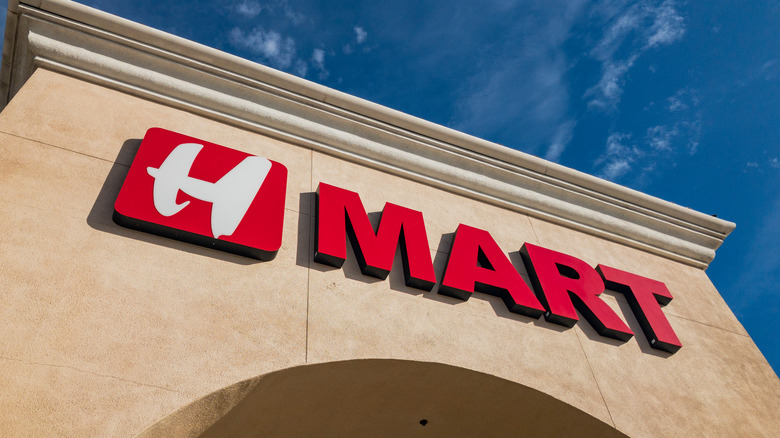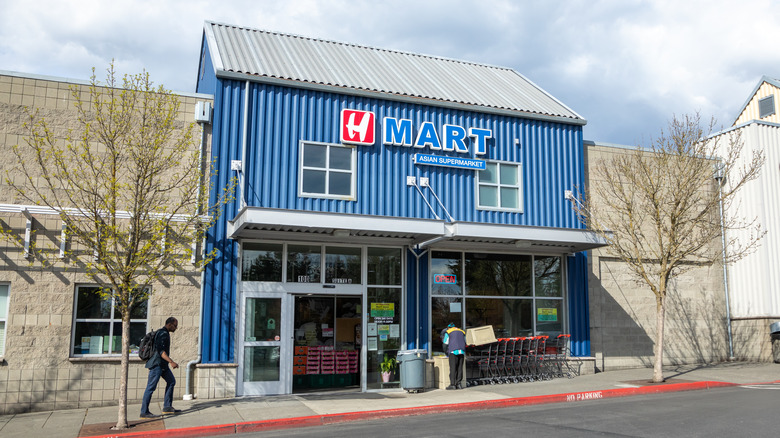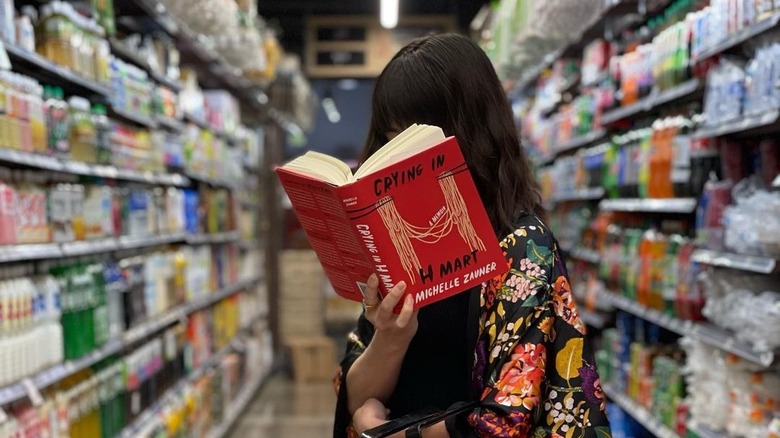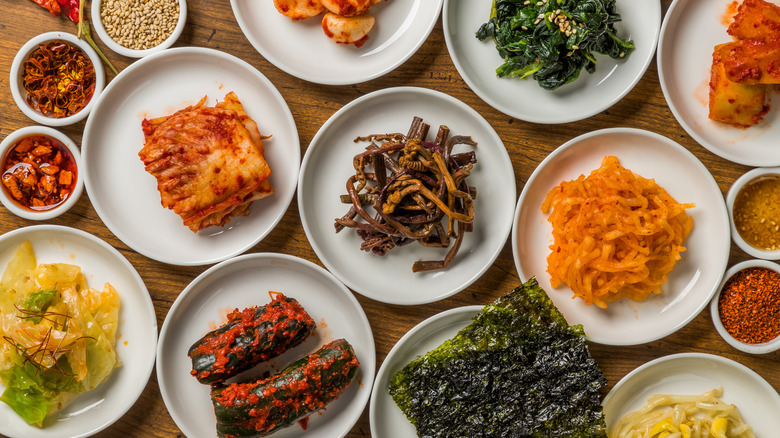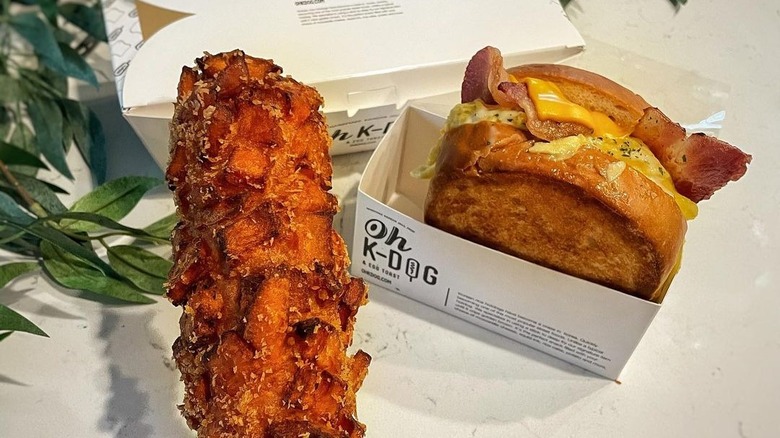The Untold Truth Of H Mart
In 2021, Korean food products are no longer relegated to the "ethnic" aisle in American supermarkets. Thanks partly to H Mart and its growing popularity among both Asian-Americans and other groups, Korean staples like kimchi, soybean paste, and roasted seaweed snack get their own large-format stores, popping up steadily in 102 convenient locations in or near some of the largest cities in the United States (via The New York Times).
This means a lot to many Korean-Americans, for whom H Mart is far more than just a grocery store. It's "a marker of a moment in time and space, when a cultural need for belonging gave way to venture capital," writes Eric Kim for Food52. Since the first H Mart opened in 1982, "gochujang" has been added to the dictionary, and K-pop group BTS has sold more North American concert tickets than Ariana Grande and Taylor Swift (via Vox). "Like these cultural moments, the ubiquity of H Mart, too, is a sign that Korean food is on its way to becoming mainstream," Kim writes.
H Mart is a family business
In the late 1970s, a farmer's son named Il Yeon Kwon left the war-impoverished countryside of South Korea, arriving in New York when only 1.5 percent of the American population was of Asian descent, according to The New York Times. In Woodside, Queens, he opened a grocery store called Han Ah Reum, which roughly translates from Korean to "one arm full of groceries," but also has a warm, affectionate connotation, explains The New York Times.
Thirty years later, that store is the first of more than 100 that now bear the name of H Mart. Kwon, 66, remains CEO of the family business, which he runs with three co-presidents: his former wife Elizabeth Kwon and their two children, Brian and Stacey (via The New York Times). The family opened several more East Coast stores in the '80s and '90s and expanded across the country in the 2000s; their next location, in Orlando, will be the largest — about the size of four football fields, reports The New York Times.
H Mart has changed daily life for many Asian-Americans
Just decades ago, Asian-Americans had even fewer places to shop for foods from their home countries; finding specific types of seaweed was never as simple as popping over to the corner store. Vilailuck Teigen, cookbook author and mom to Chrissy Teigen, used to order 50-pound bags of rice in the mail and drive 150 miles to Salt Lake City for chiles when she lived in Utah in the '80s, reports The New York Times, while Atlanta-based chef Thip Athakhanh made fish sauce from scratch and traveled from Alabama to Georgia every week to satisfy cravings for Laotian ingredients.
With locations in 17 states (per the company website), H Mart is now just a short drive away for many families missing flavors from home. Its produce section overflows with Asian greens and pears, its shelves shine with neatly arranged chips and cookies, and the layout of each store is "clean, modern, and easy to navigate," a choice made by co-president Elizabeth Kwon "to defy the stereotype of Asian grocery stores as grimy and run-down," says The New York Times.
For many Korean-Americans, H Mart is more than just a grocery store
People need only read the book "Crying in H Mart" by Michelle Zauner to understand why the grocery store is a "beautiful, holy place" to many Asian-Americans. In her New Yorker essay (the first chapter of her memoir by the same title), Zauner shares how every trip to H Mart makes her mourn her late mother, who used to show her love for Zauner by cooking Korean food. She describes the feeling of belonging she gets at H Mart, "the only place where you can find a giant vat of peeled garlic, because it's the only place that truly understands how much garlic you'll need for the kind of food your people eat."
H Mart, which specializes in Korean food but also carries products from Indonesia, Japan, China, and other Asian countries, is a brief antidote to homesickness for people missing their families' cooking or attempting to uphold their native traditions, Zauner explains. "H Mart is where you can find your people under one odorous roof, where you can have faith that you'll find something you can't find anywhere else," she writes.
H Mart has also become a place for non-Asians to learn about cultural dishes
If you've never been to H Mart, you can use Eric Kim's Food52 article as a beginner's purchasing guide. He recommends stocking your pantry with Korean staples like sesame oil and gochugaru (red pepper powder), buying prepared foods like banchan and marinated meats, exploring the snack aisles for shrimp-flavored crackers and red-bean ice cream sandwiches, or planning a cooking project from the store's array of fresh seafood or packaged bones for soups. To find out what your Choco Pie, Yakult yogurt drink, or other H Mart purchase says about you, consult the Los Angeles Times.
When non-Asians learn about Korean ingredients, California chef Brandon Jew told The New York Times, they gain not only an appreciation for a different cuisine, but also "a deeper understanding of a community and a culture." As anti-Asian hate crimes rise in the U.S. amid the pandemic, some hope that stores like H Mart can serve as anti-racist spaces. "In the context of hatred against my community, to see part of my culture being valued — it's exceptional," writer Min Jin Lee told The New York Times.
Some H Mart food courts are getting a cheffy transformation
One of Zauner's favorite things to do in her local H Mart is dine and people-watch in the food court above the grocery floor, she writes in "Crying in H Mart." Several stalls offer different specialties, such as Korean jjigaes or soups, street food like steamed dumplings and tteokbokki (chewy rice cakes served in a spicy broth with fish cakes), and Korean-Chinese fusion dishes. Most H Mart locations include a food court, though the location list online specifies the ones that don't.
While the majority of the chain's food courts are "no-frills," says Food & Wine, H Mart co-president Stacey Kwon has begun partnering with San Francisco chef Deuki Hong to modernize a few of its dining halls. They started with the Market Eatery at Austin's first H Mart, which serves young Asian chefs' interpretations of everything from kimchi-battered corn dog bites to condensed-milk panna cotta. H Mart has unveiled similar concepts in Honolulu and Phoenix and is planning others, Food & Wine reports, all in an attempt to diversify the long-standing business' offerings.
